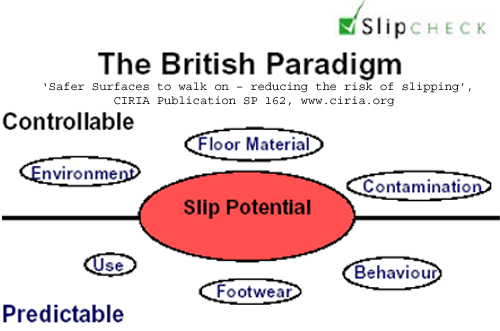How to Prevent Slip Falls?
Slip Falls Prevention Overview
What's the best way to prevent slips and falls? Based on the number of injuries in the workplace due to slippery floor conditions, there is no simple answer.
A slip and fall occurs whenever there is too little friction or traction between your feet and the surface you are walking on.
While the major cause of slip and falls is surface contamination that reduces the contact between the feet and the floor surface, there are several other factors that also contribute to slip falls like the environment, footwear, floor material, use of surface, behaviour. Some of the contaminants can be water, oil, dust and anything that reduces the traction and make the floor surface slippery.
No single solution, any one solution -- be it slip-resistant shoes, micro etching, mats, proper cleaning practices or worker awareness -- will not eliminate the hazard. OH&S professionals who want to implement, upgrade or review their slip-prevention programs need to ensure that they consider all aspects of what causes a slip and what can be done to reduce or eliminate one of the workplace's most common hazards.
Malcolm C. Robbins, a forensic engineer in San Diego who studies slip-and-fall accidents, said that unless someone can design a 100 percent slip-resistant environment and plan for the worst condition possible, the hazard cannot be eliminated. "If you say something is 90 percent effective, that still leaves 10 percent for an accident."

Above diagram is courtesy of Slip Check Pty Ltd
legislative requirements
So, what can I do as an employer or controller of premises (or my home) to prevent slip falls? While there is various legislative requirements for an Employer or Controller of Premises, identifying of foreseeable hazards and elimination or control of risks applies to everyone.
NSW Occupational Health & Safety Act requires that Controller of Premises to;
Defn; a person who has only limited control of the premises, and a person who has under any contract or lease an obligation to maintain or repair the premises.
A Controller of Premises should identify any foreseeable hazard arising from people slipping, tripping or falling
- Assess the risk of harm Clause 35
- Eliminate or control risk Clause 36
- Keep records to ensure risk is monitored and controlled Clause 35 (2) (d)
- If risks cannot be eliminated consultation is required with relevant stakeholders.
Risk Assessment and control
Evaluation of Risk using Qualitative Risk Assessment- Evaluate risk in terms of likelihood and consequences
- Review available information
- Identify treatments to control risk
- Document records to ensure risks are controlled
We can predict the Use of the surface, type of Footwear will be used on the surface and Behaviour of people and equipments using the floor surface and can develop Environmental, Floor Surface Material and Contamination controls as well as guide on suitable Footwear and educate Behaviour.
- Environment: adequate lighting, covering exposed areas, slopes or gradients, etc)
- Floor Surface Materials: employing non-slip surfaces and / or applying remedial non slip treatments to reduce / eliminate likelihood of slip falls. Please note that you also want to consider some other aspects like clean ability of the surface, trip hazard, product suitability and effectiveness, maintenance, esthetical appearance, etc,. of any of the solutions These slip fall prevention measurements can be;
- Good housekeeping
- Mats at entry foyers
- Chemical micro etching
- Grinding
- Shot blasting
- Coatings
- Adhesive tapes
- Contamination: develop and implement Contaminated Floor Prevention policies, creating and maintaining a Floor Safety / Slip Resistance Register
Footwear: While any slip-prevention program should include several elements, slip-resistant footwear is a key to making the program work. To make sure that a shoe is truly slip-resistant, ask the manufacturer for test results that should come from an independent lab to ensure that results are valid.
The two factors to achieving slip resistance with a shoe: the rubber compound and the tread pattern design, including the tread's surface-to-void ratio. The rubber compound needs to be soft enough to provide slip resistance but hard enough to last and maintain its tread pattern after contact with floor surfaces and contaminants. The tread pattern design should have a grid pattern that channels water, grease and other residues away from the bottom of the shoe.
Behaviour: Create Employee Awareness by encouraging and rewarding those who practice safe working habits and maintain a clean work environment. Workers can reduce the risk of slipping by:
- Taking their time and paying attention to where they are going;
- Adjusting their stride to a pace that is suitable for the walking surface and tasks being performed;
- Walking with feet pointed slightly outward;
- Making wide turns at corners; and
- Ensuring that items being carried or pushed do not prevent them from seeing spills.
- Include employees in all phases of a slip-prevention program. "They're going to know best about the work areas, hazards and solutions."
For further information regarding to the development of the Floor Safety / Slip Resistance Register click on Carl Strautins or to get your nearest Authorised Dealerís contact details or click on Enquiry and provide us with your details and specific concern and your nearest Safety representative will contact you.





